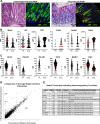Single-cell transcriptional analyses of spasmolytic polypeptide-expressing metaplasia arising from acute drug injury and chronic inflammation in the stomach
- PMID: 31481545
- PMCID: PMC7282188
- DOI: 10.1136/gutjnl-2019-318930
Single-cell transcriptional analyses of spasmolytic polypeptide-expressing metaplasia arising from acute drug injury and chronic inflammation in the stomach
Abstract
Objective: Spasmolytic polypeptide-expressing metaplasia (SPEM) is a regenerative lesion in the gastric mucosa and is a potential precursor to intestinal metaplasia/gastric adenocarcinoma in a chronic inflammatory setting. The goal of these studies was to define the transcriptional changes associated with SPEM at the individual cell level in response to acute drug injury and chronic inflammatory damage in the gastric mucosa.
Design: Epithelial cells were isolated from the gastric corpus of healthy stomachs and stomachs with drug-induced and inflammation-induced SPEM lesions. Single cell RNA sequencing (scRNA-seq) was performed on tissue samples from each of these settings. The transcriptomes of individual epithelial cells from healthy, acutely damaged and chronically inflamed stomachs were analysed and compared.
Results: scRNA-seq revealed a population Mucin 6 (Muc6)+gastric intrinsic factor (Gif)+ cells in healthy tissue, but these cells did not express transcripts associated with SPEM. Furthermore, analyses of SPEM cells from drug injured and chronically inflamed corpus yielded two major findings: (1) SPEM and neck cell hyperplasia/hypertrophy are nearly identical in the expression of SPEM-associated transcripts and (2) SPEM programmes induced by drug-mediated parietal cell ablation and chronic inflammation are nearly identical, although the induction of transcripts involved in immunomodulation was unique to SPEM cells in the chronic inflammatory setting.
Conclusions: These data necessitate an expansion of the definition of SPEM to include Tff2+Muc6+ cells that do not express mature chief cell transcripts such as Gif. Our data demonstrate that SPEM arises by a highly conserved cellular programme independent of aetiology and develops immunoregulatory capabilities in a setting of chronic inflammation.
Keywords: GASTRIC CANCER; GASTRIC METAPLASIA; GASTRITIS.
© Author(s) (or their employer(s)) 2020. Re-use permitted under CC BY-NC. No commercial re-use. See rights and permissions. Published by BMJ.
Conflict of interest statement
Competing interests: None declared.
Figures




References
-
- Bray F, Ferlay J, Soerjomataram I, et al. . GLOBOCAN estimates of incidence and mortality worldwide for 36 cancers in 185 countries. CA Cancer J Clin 2018;2018:394–424. - PubMed
-
- Correa P, Shiao YH. Phenotypic and genotypic events in gastric carcinogenesis. Cancer Res 1994;54(7 Suppl):1941s–3. - PubMed
Publication types
MeSH terms
Substances
Grants and funding
LinkOut - more resources
Full Text Sources
Molecular Biology Databases
